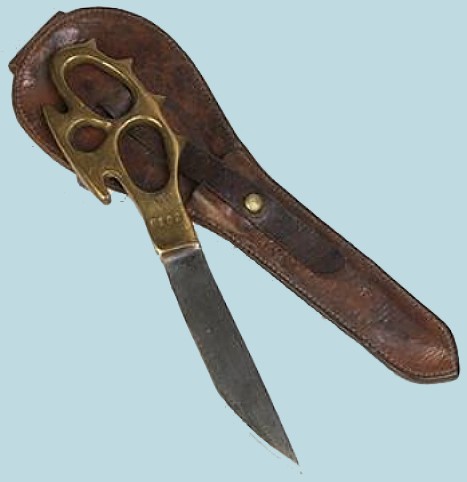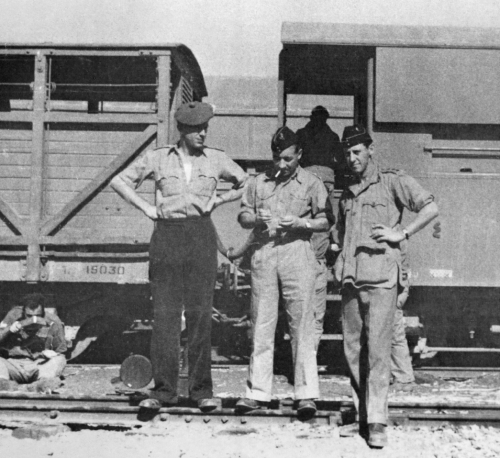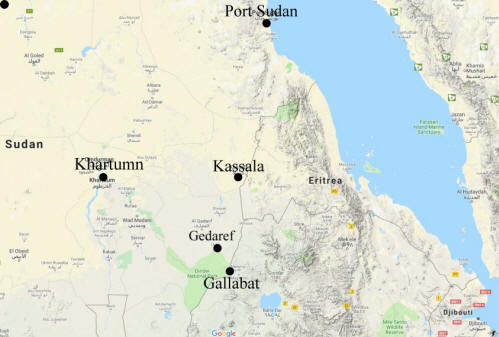|
52
(Middle East) Commando - North East Africa
An Integral Part of 'Layforce'
Recruitment and Training
 Recruitment into 52 Commando was voluntary but the Commanding Officers of
Regiments and Battalions had the power to block any application they
wished - a power they used to retain their best men in whom they had
invested a great deal of training. The corollary of this practice
witnessed the approval of applications from some men whose COs considered
less proficient. The newly raised No 52 Middle East Commando
had their fair share of these men, but as the training progressed, they
forged themselves into an effective fighting force. Recruitment into 52 Commando was voluntary but the Commanding Officers of
Regiments and Battalions had the power to block any application they
wished - a power they used to retain their best men in whom they had
invested a great deal of training. The corollary of this practice
witnessed the approval of applications from some men whose COs considered
less proficient. The newly raised No 52 Middle East Commando
had their fair share of these men, but as the training progressed, they
forged themselves into an effective fighting force.
[Photo; Knuckle-duster knife
produced during 1940-41 for use by members of 50, 51 and 52 Commandos.
These three Commandos were raised in the Middle East and the knives were
made locally in Egypt. The hilt of the knife takes the form of a
substantial brass knuckleduster, on to which the single-edged blade is
brazed. It seems likely that more were produced than were strictly
required by the three Commando units, as numerous examples survive.
Courtesy of Imperial War Museum. © IWM (WEA 659)].
No
52 Middle East Commando began its short life on the 2nd of November 1940.
Their initial cadre was 380, including 19 officers, drawn from 35
different Regiments or Corps serving in the East Mediterranean theatre of
operations. Most were, of course, from the regular Army with some from the
Yeomanry of the 1st Cavalry Division. They were to be commanded
by Harry Fox-Davies, but due to illness, George Young took his place
before the transfer occurred. Subsequently Lt Col Peter Symons became their first
CO. They were a light raiding force with no heavy weapons at their
disposal or the transport to carry them. They made the best of a bad
situation by scrounging whatever transportation they could find.
A
training and administrative depot was set up on 25th January 1941 under the
command of Major D W Melville. Its primary purpose was the provision of
trained replacements for the inevitable future losses. There was a shortfall in
both men and equipment in this theatre of the war and there was little
prospect of an early improvement. Against this background, plans for an Indian,
Polish and 4th British Commando Unit, to be called No 53 Middle East
Commando, were shelved.
52
Commando's training programme lasted 6 weeks, half the time of their
counterparts back in the United Kingdom. As with No 50 Commando, their
training included demolition work, seamanship, map reading, knots and
lashings, first aid, weapons training and methods of attack including
guerrilla tactics and unarmed combat. Desert training included physical
fitness and caring for and riding camels!
 Early Deployments Early Deployments
The
5th Division attacked Italian positions at Kassala and Gallabat in Sudan. While the attack stalled, positions gained were held pending the
arrival of fresh supplies and reinforcements. In the mistaken belief that
this was an appropriate role for 52
Commando, the 5th Division's Staff
Officers deployed them as reinforcements to fill out
the ranks of their infantry.
On the 16th December 1940, the Commandos left
Geneifa, on the Suez Canal, by train for Port Said. Procuring sufficient
weapons and equipment was a constant problem and opportunities for doing
so were diminishing. At Port Said, they embarked on the 12,000 ton, French
ship, President Doumer owned by Bibby Brothers and Co of Liverpool
and operating out of Aden.
The 2nd
Battalion of the Highland Light Infantry was also on board. Relations
between the two groups took a turn for the worse when the Commandos
accused the Scots of misappropriating their Christmas goodies including a
quantity of whisky. Being the national 'beverage' of Scotland, it was,
perhaps, unsurprising that the 'Jocks' shouldered the responsibility for
the
losses, whether they were guilty or not!
 Their
initial destination was Port Sudan on the Red Sea, over 900 miles to the south.
It proved to be an extremely uncomfortable journey in very hot weather so
their arrival was a great relief for everyone. Their
initial destination was Port Sudan on the Red Sea, over 900 miles to the south.
It proved to be an extremely uncomfortable journey in very hot weather so
their arrival was a great relief for everyone.
[Personnel of 52 (Middle East) Commando en
route, by train, to Gadaref. From left to right: John Milman (HLI), the
second in Command, George Young (RE), the Commanding Officer and Bill
Seymour (Scots Guards), the Adjutant. © IWM HU 68726].
Their next destination was Gedaref, the railhead for the forces in Gallabat
in the Metemma sector. A direct overland journey was not possible because the
Italians occupied Kassala through which the direct railway line passed.
After 3 days they arrived at Gedaref on the afternoon of the 22nd
December and spent the next 2 days or so getting
themselves organised. The men were paid and allowed free time off camp.
Inevitably, there was
trouble with the locals which led to several stabbings. The overstretched
Military Police relied on the Commando's own officers
to round up their men!
On
Christmas Eve, the Commando paraded and were transported by trucks to an
area close to the front line. There, they came under the command of the 9th
Infantry Brigade (5th Indian Division) led by Brigadier Ashton G O Mayne. By May of 1942, Mayne,
himself, would command the
Division.
 The Commandos were briefed on the disposition and strength of the Italians.
The overall strength of the enemy was numerically greater but their number
included many native troops. The Italians also had command of the air since Allied air cover
was almost not existent. The British forces were primarily defending their
positions mounting opportunistic attacks on enemy forces and positions.
Aerial photos and intelligence from the field were inadequate for
effective planning, so No 52 Middle East Commando's were tasked to patrol
the front line area to gather information and engage with the enemy
where prudent to do so. The Commandos were briefed on the disposition and strength of the Italians.
The overall strength of the enemy was numerically greater but their number
included many native troops. The Italians also had command of the air since Allied air cover
was almost not existent. The British forces were primarily defending their
positions mounting opportunistic attacks on enemy forces and positions.
Aerial photos and intelligence from the field were inadequate for
effective planning, so No 52 Middle East Commando's were tasked to patrol
the front line area to gather information and engage with the enemy
where prudent to do so.
The Commandos needed
time to acclimatise to the local
environment which was well over 1,000 miles south of the more familiar
surroundings in Palestine and Egypt. It was the dry season and the
landscape was covered with bushes,
small trees and swathes of elephant grass almost 8 feet tall. The nearby Atbara
river, the last tributary of the Nile before it reached the
Mediterranean, flowed northwards in the wet season. It lay on the Commandos left flank and was
little more than a series of pools. However, it was the only source of water for
everyone living in the area - friend and foe alike.
Young and his accompanying officers set out on Christmas Day to
reconnoitre the Italian positions, guided by men of the Sudan Defence
Force. By the 3rd
January 1941, Young was sufficiently knowledgeable about the terrain, road
communications and the deployment of the enemy to plan for the tasks
assigned to his command.
C
Company, under the command of Captain David Smiley of the Royal Horse
Guards, undertook the Commando's first patrol with an advance section, followed
by 3 platoons in single file. They came under fire from high in some trees
and from nearby elephant grass. Gunfire was immediately returned and grenades
were thrown
which set the bush alight. The brief exchange was swiftly broken off by
the native soldiers as they fled leaving behind two dead. The
Commandos suffered one casualty from a minor bullet wound.
On the 8th of January, the Commandos carried out
a long distance raid on the enemy's lines of communications between Khor
Kumar and Khor Abd-er Razzag.
The next target was an important crossing on the Atbara river about a two day march
away. The Sudan Defence Force provided a guide for the reconnaissance
mission to establish what presence if any, the enemy had there. In the
event the crossing was unguarded. In the near certain knowledge that the
enemy would use the crossing at some point an ambush was planned and put into effect by Major John Milman, of the
Highland Light Infantry, who had been on the earlier reconnaissance.
George Young, the original leader, was out of action due to illness.
The
plan envisaged 2 companies of Commandos trekking 15 miles or so behind
enemy lines to set up an ambush. Major Milman was not involved in the
planning of the 3-day operation and the target area was unfamiliar to him.
Both factors, taken together, amounted to a significant disadvantage. Each
Commando carried rations for 3 days and a forward base, prepared by their
Adjutant, Major William Seymour of the Scots Guards, was available to them
at the end of the first day. They prepared their ambush for the night
of day 2 leaving the 3rd day for their return.
[Later in the war Major
Seymour serve with Mission 204 with distinction].
Milman and his men set off on the 10th January keeping to the planned
schedule for reaching the river. However, a patrol sent out had not
returned when expected because they had been unable to find the
river. In addition, it became clear food supplies were insufficient for
everyone so Milman ordered one of the Companies back to base leaving their
food supplies behind. The plan was beginning to unravel.
Meantime
Brigadier Mayne mounted a diversionary
action to draw the enemy from the ambush area but unfortunately, Milman had no knowledge
of it. Believing that his forces were in danger of being
compromised, he ordered the remaining company back to base. He then
carried out his own reconnaissance locating both the river and the road.
The operation was unsuccessful with much of the blame falling on Milman, but some blame lay with the planners and even Mayne
himself who, like so many other senior officers in these early days
of the war, had little idea of how to use the Commando's irregular
form of warfare.
A further raid into this area began on the 17th January,
essentially a carbon copy of the previous one with a few modifications.
This time George Young took command of the force and as before, 2
companies moved out to Khor Ghumsa in the evening, where they laid up
until the afternoon of the 18th. They then set out towards the Atbara River where Seymour had
once more prepared a forward base for the men to lay
up. On the night of the 19th/20th, they
planned to attack the Gondar road and return to their forward base. However, on the 18th,
the guide leading Seymours party lost his way wasting 8 hours causing George Young
to postpone the attack
to the 20th. On an otherwise frustrating day, they received the
welcome news that the Italians had withdrawn from Kassala to
a new position in the area of Agordat and Barentu.
On the 19th they were involved in a brief engagement with enemy
troops who were able to bring up reinforcements causing the party to
withdraw. Their Abyssinian guide was wounded in the leg, left behind in a
safe, concealed location and recovered the following
day by a stretcher party.
At 18.00 hours on the 20th, the main body of men crossed the
river and by 2100 hours had reached the road and deployed to set up the
ambush. C Company became engaged with an Italian patrol and suffered 2
killed and 2 wounded. They were ordered by Young to hold their ground
while B Company was ordered to withdraw to positions held by his HQ
section which would then provide support for C Company. The enemy
re-engaged with C Company forcing Young to withdraw. They returned to base
on the 22nd of January but one of the Commandos, 2695905 Lance
Sergeant Ronnie Harrison, aged 20, who had been wounded was left
behind in error. He hailed from Yorkshire and served in the 2nd Battalion
of the Scots Guards. He has no known grave but is commemorated on the Khartoum
Memorial.
A
third and final attempt to attack the enemy on the Metemma-Gondar road was
thwarted when the Commandos encountered a strong enemy force. After
engaging with the enemy they were forced to withdraw due to their superior
numbers and firepower. The Commando suffered a few light injuries.
Routine patrols continued but the Commando had only one more engagement
with the enemy before they (the enemy) began to withdraw from the area. A
Company, as part of a Brigade operation, attacked the enemy on positions
known locally as the 'Three Bumps.' The aim was to force the early withdrawal
of the Italian forces which was, in any event, thought to be imminent.
During the attack the Commando sustained one casualty wounded.
On
the 31st January, a Commando patrol discovered that the enemy
had withdrawn from Djebel Dufeir and Djebel Negus. This withdrawal,
together with that in Abyssinia, brought an end to the Italians brief
period in East Africa.
The nature of the conflict was changing fast as Brigade HQ prepared to
pursue the retreating enemy with what transport they had, reverting to
standard infantry tactics. The Commandos had served their purpose and
were, effectively, stood down. They were withdrawn to a camp close to the
Atbara River until ordered to Gedaref where men of No 51 (Jewish) Commando
were billeted. There was no transport so the journey of over 100 miles, on
foot, took several days. Their earlier training in Egypt, especially during
desert exercises, proved its worth as the men took the march in good
stead.
On February 24th at 16.00 hours they boarded a train for
Kassala, arriving there at 01.00 hours on the 25th. There was a
short period of
rest and recuperation until the 4th March, followed by training
for operations in Abyssinia which would include operations in the
mountains. However, with the withdrawal of the Italians from Abyssinia on the 3rd
of March, 52 Commando received orders to return to Egypt by a mix of rail
and river. They arrived at Abbabassia on the 9th, then a camp at
Taheg, close to Cairo. They finally reached their regular camp at Geneifa, on the
Suez Canal, on the 23rd of March 1941.
No 52 Middle East Commando, were amalgamated with No 50 Middle East
Commando, combining as 5 Companies, each Company having two troops of 50
men each. This restructuring brought consistency with the United Kingdom
formed Commandos forming other Battalions for Layforce.
Lt. Col. George Young, Royal Engineers, was in overall command of No 50/52
Middle East Commando (D Battalion Layforce). His Company Commanders were:
A Company Captain K.E. Hermon Durham Light Infantry
B Company Captain C Parish Royal Sussex Reg.
C Company Captain W.J. Burton York and Lancaster Reg
D Company Captain R. Boyle Black Watch
E Company - L.N.R. Wilson Royal Sussex Reg.
In April they moved to Sidi Bishr on the outskirts of Alexandria, and on
the 24th May they embarked for Crete.
George Young, in a report he wrote after the second of the three failed
road attacks, opined that the size of the force he deployed was inadequate
and that the Commandos training would benefit from more standard infantry
tactics. It was also evident that a number of his men fell short of the
standard required. They were weeded out and when men lost through illness were
added, his force was depleted by 50 men. To that were added 60 men who
succumbed to malaria.
In Remembrance.
4919364 Pte. Joseph Flood aged 24 of the South Staffordshire Regiment
2657950 Gdsm. George Howarth aged just 21 and from the 3rd
Battalion Coldstream Guards remained behind this being the human side and
cost of war. His date of death is recorded as the 5th January
1941 making him No 52 Middle East Commando's first
fatality.
2695640 L/Cpl. Edward Norman aged 22 and from the 2nd Battalion
Scots Guards,
4621750 Pte. Lionel Vokes aged 24 of the 1st Battalion Sherwood
Foresters,
Bibliography
Charles Messenger The Commandos 1940-1946
Charles Messenger The Middle East Commandos
H W
Wynter Special Forces in the Desert War 1940-1943
WO
361/124
Further Reading
There are around 300 books listed on our 'Combined Operations Books' page which can be
purchased on-line from the Advanced Book Exchange (ABE) whose search banner
checks the shelves of thousands of book shops world-wide. Type in or copy and
paste the title of your choice or use the 'keyword' box for book suggestions.
There's no obligation to buy, no registration and no passwords. Click
'Books' for more information.
50 (Middle East) Commando
Acknowledgements
Researched and written by
Alan Orton.
Redrafted for website presentation by Geoff Slee and approved by the
author before publication.
|





